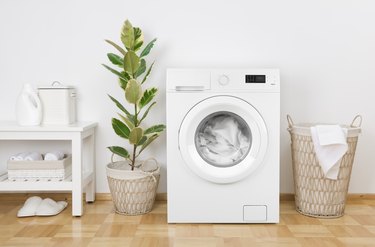
A washing machine's filter can be located on different parts of the machine, and it may even be part of the pump system. GE washing machines are no exception. Because newer models are designed much more efficiently than old ones, in order to find out where your filter is located or if it needs to be cleaned, you must first know your machine's year and what type of unit you have.
GE Washer Filters
Video of the Day
Washing machine filters can be found along the top rim of the drum, at the end of the drainage hose, under the center agitator's cover or in the front of the unit behind a small hatch. However, keep in mind that newer models do not even have separate filters. Some have self-cleaning filters in their pumps, so this means less maintenance.
Video of the Day
GE models made before 1993 have a "Filter-Flo" pan on the top of their agitators; these have pinpoint holes that trap particles. Lint can then be removed after the final rinse cycle. If the filter is clogged, heat up a pan with equal parts water and vinegar to 160 degrees Fahrenheit and soak it in the pan for 15 minutes. Brush both sides with a stiff brush under running water. These pans can also be soaked overnight in vinegar and water.
GE washing machine parts changed in 1994 due to a more modern invention. The Filter-Flo was replaced with a self-cleaning filtering ring. The end of the wash and rinse spray cycles do the work on these models. The lint is then carried down through the pump and out through the drain. No cleaning is needed for these.
New and Improved GE Washer Filters

From 1995 to 2000, GE top-loading washers used crescent-shaped, plastic, fine-mesh lint filters located at the bottom of the wash baskets. They can be found beneath the agitators. Water flows right through the two crescent-shaped filters. The lint is then forced off the filters and into the drain. These also do not need to be cleaned or replaced. If something major clogs them, like a rubber rug backing, professional service may be needed.
In 2001, the fine-mesh filters were replaced, and most of the washers were updated with larger holes under the agitator and better pump systems. This improved drain system lets water flow in and out of the basket and into the bottom of the tub along with the lint and other small particles. No maintenance is required.
However, there is one exception: the new Space-Saving and Spacemaker washer models manufactured since June 2018. These machines have rectangular-shaped lint filters in their wash baskets that need to be cleaned. Unclip the blue filters from the side of the wash basket by pushing down gently on the top of the filter. Open it, remove the lint and rinse in warm water. Close it and replace it by snapping the filter back into place.
Other GE Washing Machines
GE's Spacemaker washing machines are washer/dryer combo units that are designed for smaller spaces and smaller families. There are 37 different combinations on its website, with washer capacities ranging from 3.7 to 4 cubic feet and dryers ranging from 4.1 to 5.9 cubic feet. These come in both electric and gas models.

GE also makes large-capacity, portable washing machines that can be moved to different rooms as needed. If you have a GE washer and are unsure about how the filter needs to be maintained or if it even does, your best resource is the product manual. If you cannot locate the manual that came with your machine, you should have no problem finding the manual online.